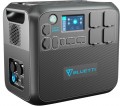Add to comparison |  |  |
|---|---|---|
| BLUETTI AC200MAX | BLUETTI PowerOak AC200P | |
from $995.67 | from $1,577.00 | |
| User reviews | ||
| TOP sellers | ||
4 USB A ports, 1 USB C port. Car cigarette lighter, DC5521 port. LiPo4 battery. Jumps up to 4800 watts are allowed. Touchscreen. Wireless charging power 15W (2 fields). | 4 USB A ports, 1 USB C port. Car cigarette lighter port DC5521. Jumps up to 4800 W are allowed. Touchscreen. LiFePo4 battery. Wireless charging power 15 W (2 fields). | |
| In box | charging station | charging station |
| Rated power | 2400 W | 2000 W |
| Peak power | 4800 W | 4800 W |
| Output waveform | sinusoid (PSW) | sinusoid (PSW) |
Outputs | ||
| Sockets (230 V) | 4 | 2 |
| USB A | 2 pcs 5В/3A 15 W | 4 pcs 5В/3A |
| USB A (quick charge) | 2 5-12В/3A 18 W | |
| USB C | 1 pcs 100 W | 1 pcs 3 A 60 W |
| Wireless charger | 2 zones 15 W | 2 zones 15 W |
| Car cigarette lighter | ||
| Add. ports | 4 pin Aviation Socket | |
Inputs (station charging) | ||
| From solar panels | ||
| DC input | 1 pcs DC7909 | 1 pcs DC7909 |
Battery and charging time | ||
| Connecting an additional battery | ||
| Battery type | LiFePO4 | LiFePO4 |
| Battery capacity | 2048 W*h | 2000 W*h |
| Charging cycles | 3500 | 3500 |
| Charging time (socket) ≈ | 360 min | 300 min |
| Charging time (socket + solar panel) ≈ | 150 min | 150 min |
| Charging time (solar panel) ≈ | 210 min | 240 min |
| Charging power (socket) | 500 W | 500 W |
| Charging power (solar panel) | 900 W | 700 W |
| Charging power (socket + solar panel) | 1400 W | 1400 W |
General | ||
| Smartphone synchronization | Bluetooth | |
| PSU | external | |
| Display | ||
| Carrying handle | ||
| Operating temperature | -20 °C ~ +40 °C | 0 °C ~ +40 °C |
| Dimensions | 387x420x280 mm | 386x420x280 mm |
| Weight | 28.1 kg | 27.5 kg |
| Warranty | 2 years | 4 years |
| Added to E-Catalog | october 2022 | september 2022 |
When comparing the BLUETTI AC200MAX and BLUETTI PowerOak AC200P charging stations, several key differences can be noted. The AC200MAX boasts a higher rated power of 2400 W and features 4 outlets at 230 V, whereas the AC200P offers 2000 W and only 2 outlets. Both devices support peak power up to 4800 W, but the AC200MAX can charge faster thanks to a higher solar charging power (900 W versus 700 W for the AC200P). Both units use LiFePO4 batteries with 3500 charge cycles, but the AC200MAX has a larger battery capacity (40 Ah compared to 2000 Wh of the AC200P). In terms of convenience, both models have touch displays and carrying handles, but the AC200P offers a longer warranty of 4 years compared to 2 years for the AC200MAX. Users note the high reliability and performance of both devices, although the AC200MAX might be the preferred choice for those who need more power and functionality.